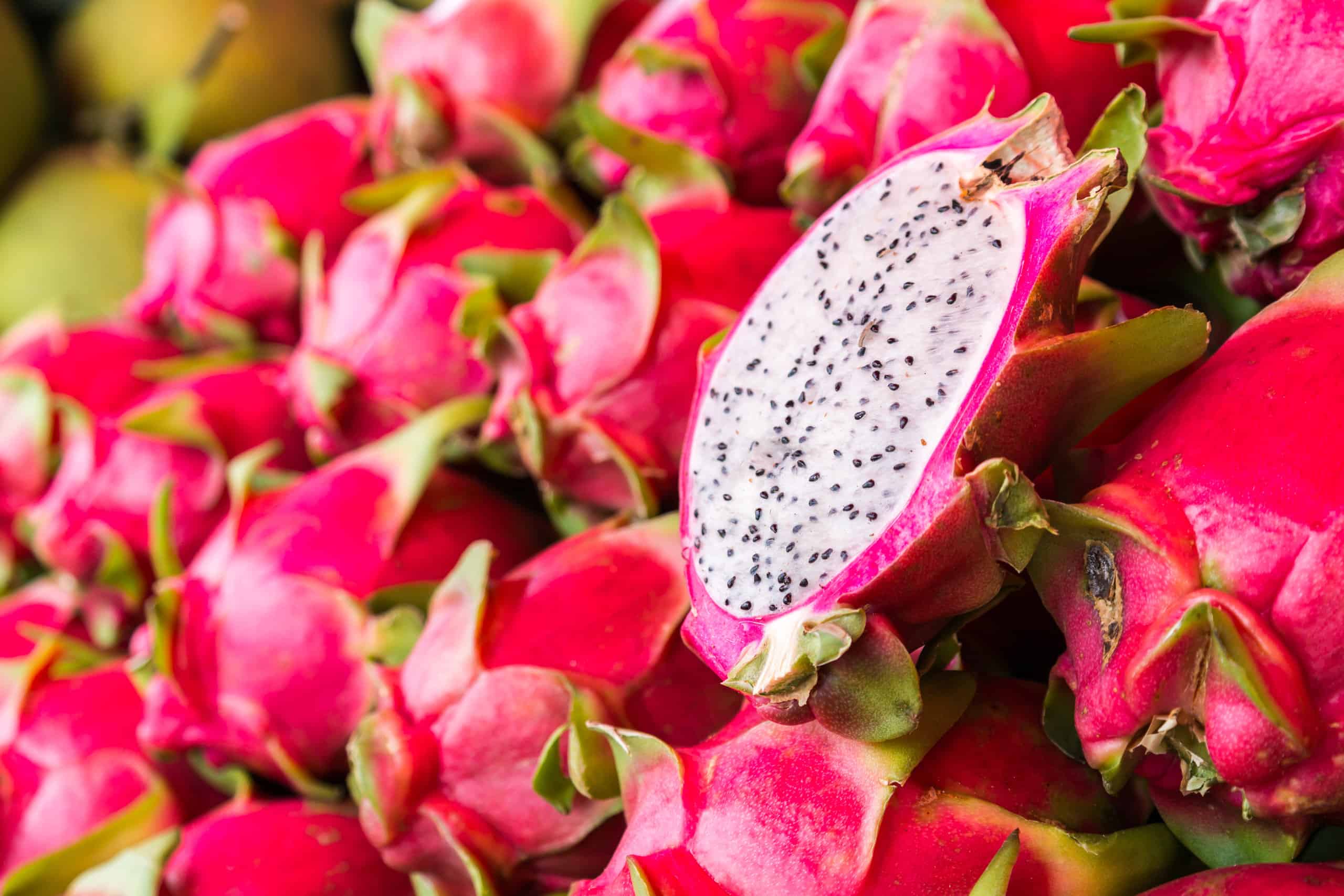Step into a world bursting with vibrant hues and natural artistry: the realm of multi-colored fruit! These delicious wonders don a spectrum of shades, captivating both the eyes and taste buds. From the sun-kissed blood oranges with their warm, citrusy glow, to the mysterious allure of prickly pear, these fruit go beyond ordinary flavors. Let’s take a look at some of the most unique-looking multi-colored fruit!
For the sake of brevity, today we’ll be looking at fruits that have multicolored exteriors, regardless of the color of the inside of the fruit. However, it’s worth noting that a lot of the multi-colored fruits on our list have uniquely colorful inner fruits as well!
1. Mango
The mango fruit is a tropical treat enjoyed across the globe. Its vivid colors vary from lush green to vibrant yellow, orange, and even dashes of red, showcasing the diverse spectrum of its ripeness. These colors depend on the type of mango and how mature it is. Varieties like the honey mango are completely golden orange, while the Kent mango is almost completely green with some orange, blush-like hues mixed in.
Mangoes are predominantly grown in warm tropical regions such as Asia, Africa, and Central America. These areas provide the ideal climate for mango trees to flourish. Countries like India, Thailand, and Mexico are known for their abundant mango production.
Aside from its delightful taste, mangoes pack a nutritional punch. They are a good source of vitamins, including vitamin C, which supports a strong immune system, and vitamin A, crucial for eye health. The fiber content aids digestion and promotes gut health. Natural sugars in mangoes offer a quick energy boost. Just as well, mangoes contain antioxidants that fight off oxidative stress and promote one’s overall well-being.
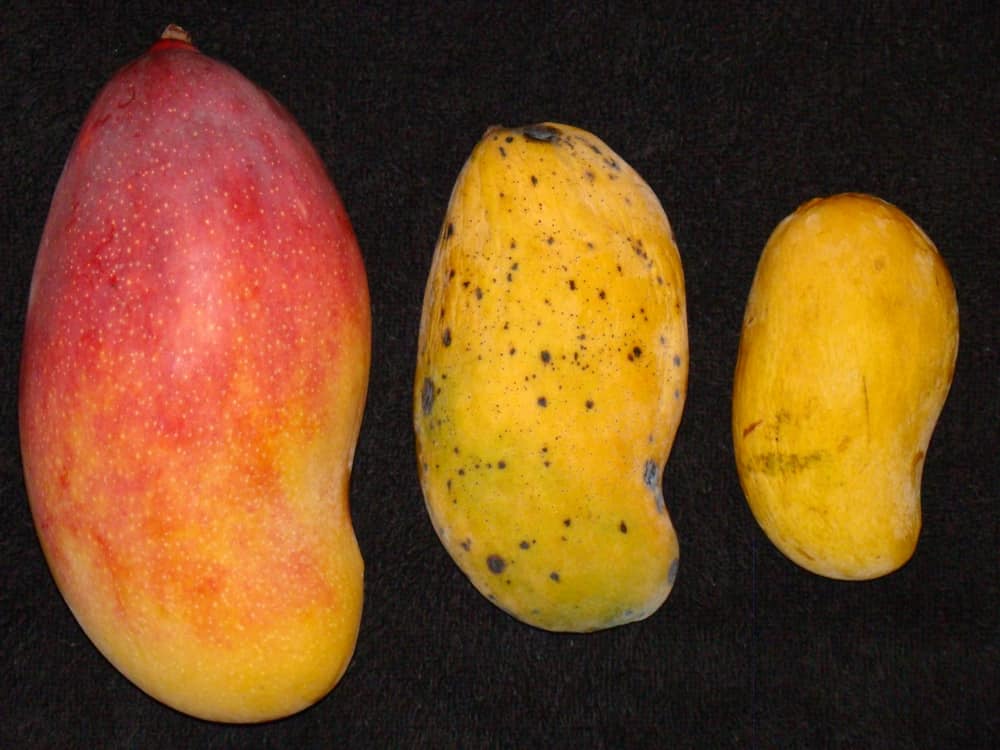
Mangoes can come in a range of colors depending on the specific variety.
©[email protected] Thaumaturgist / CC BY-SA 3.0 – Original / License
2. Starfruit
The starfruit, often called carambola, has quite an unusual shape in addition to being a multi-colored fruit. When cut in half, it has a recognizable star shape. This fruit is originally from Southeast Asia, but it’s now cultivated in many other tropical climates. If you’re lucky, you might be able to find this type of fruit at your local grocery store or international market.
The starfruit’s colors range from pale yellow to vibrant golden when ripe. Its unique shape and appealing color make it a popular choice for garnishes and fruit platters. When sliced, the starfruit reveals its star-shaped pattern, adding an elegant touch to culinary presentations.
The starfruit has an extraordinary flavor profile. Citrusy, somewhat sweet, and slightly tangy are all words one could use to describe the flavor. The crisp texture and edible skin make for a wonderful complement to the luscious meat of the fruit.
Beyond its visual and taste appeal, the starfruit brings valuable nutrients to the table. It’s a fantastic source of vitamin C and is quite low in calories. Coupled with its high water content, this is a great snack for those who want to lose some pounds or just stay hydrated!
All that said, it’s important to mention that starfruit contains natural compounds that can be potentially harmful to individuals with kidney disease or kidney problems. These compounds may not be effectively filtered by compromised kidneys, potentially leading to health complications.
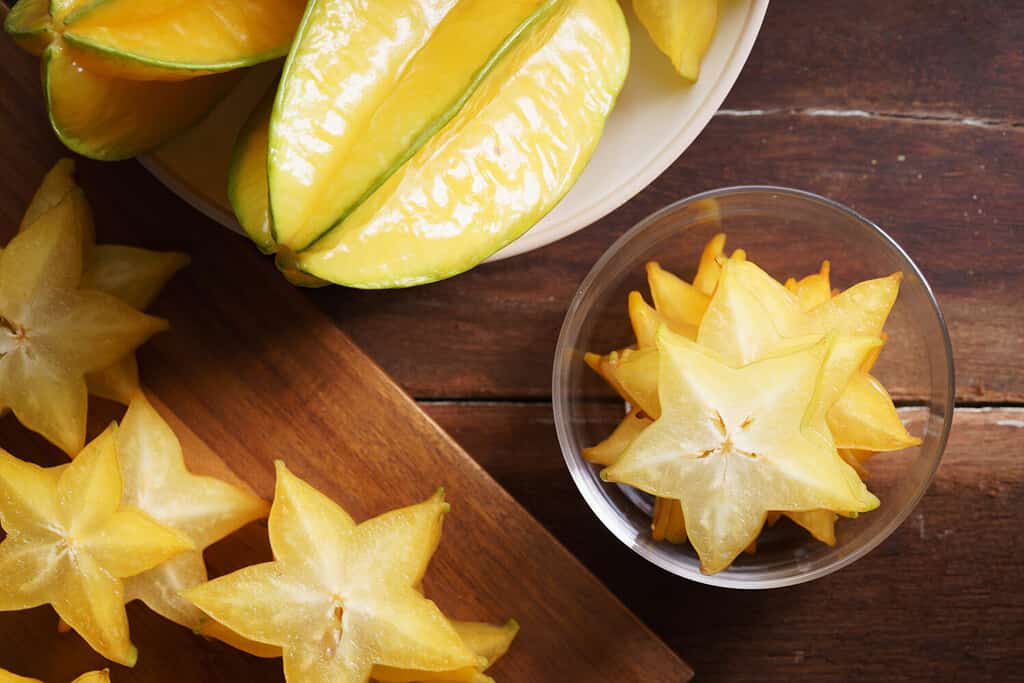
Starfruits are water-heavy fruits that are great for hydration.
©janecocoa/Shutterstock.com
3. Prickly Pear
Prickly pears, or nopales, are a kind of cactus fruit that is both colorful and thorny. This iconic fruit is native to the Americas. Its natural range includes most of North and South America. However, it is most commonly found in places like Mexico and the southern United States. They are particularly abundant in Arizona.
Prickly pear fruit is a very aesthetically-pleasing fruit with dark reds and purples to bright oranges and yellows. The exact shade might change according to the type and maturity. Small, fine spines cover the outer layer of the fruit and must be gently removed before ingestion to prevent irritation.
The prickly pear has a distinctive and revitalizing flavor. The flavor of the flesh is like a combination of watermelon and pear, being both sweet and somewhat sour. Depending on the variety, it might have a silky or gritty feel.
The prickly pear is a nutritious fruit as well. Its high fiber content promotes digestive health. The antioxidants in the fruit, such as vitamin C and betalains, may help fight against free radicals and inflammation.
Prickly pear has also been researched for its ability to aid in blood sugar regulation and cardiovascular health. The favorable benefits may be due in part to the beneficial substances it contains.
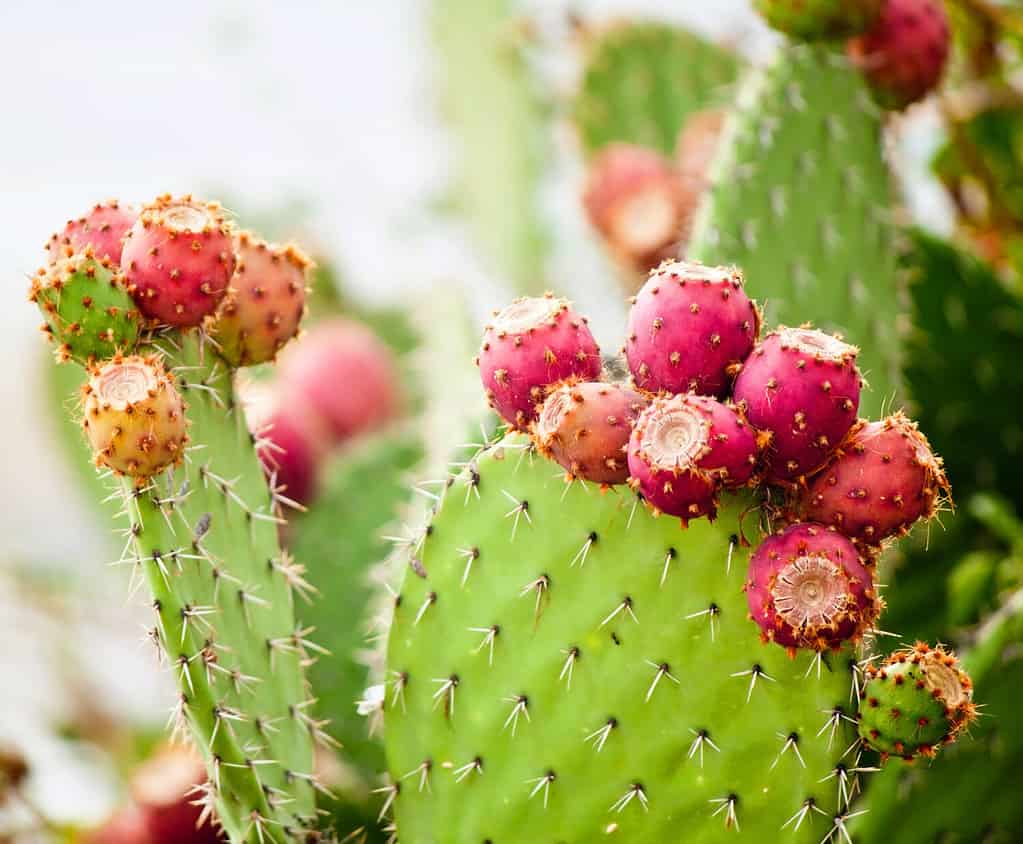
Prickly pear fruit must be cleaned of their spikes before eating.
©fischers/Shutterstock.com
4. Cherimoya
The cherimoya fruit is also known as the custard apple. And if you’re not from South America, you might not have seen this unique fruit before! Native to the Andes, this fruit is now cultivated in some Asian countries and Australia. However, it’s still a rare treat to find in American grocery stores. Try looking for them at your local international market!
This fruit’s exterior can range from light green to yellow. It has a somewhat bumpy surface and a unique overall shape.
When it comes to taste, the cherimoya offers a luxurious treat. Its creamy, custard-like texture is indulgent, and its flavor is a harmonious blend of tropical notes, including pineapple, banana, and citrus. The flesh is typically white, with large, glossy black seeds embedded within. These seeds should be avoided, as they are not meant for consumption.
The cherimoya boasts high fiber content that aids digestion and keeps the digestive tract in excellent condition. The fruit is also a good source of vitamin C, vitamin B6, and potassium, among other vitamins and minerals. Potassium helps maintain normal heart function and blood pressure, while vitamin C is essential for a healthy immune system.
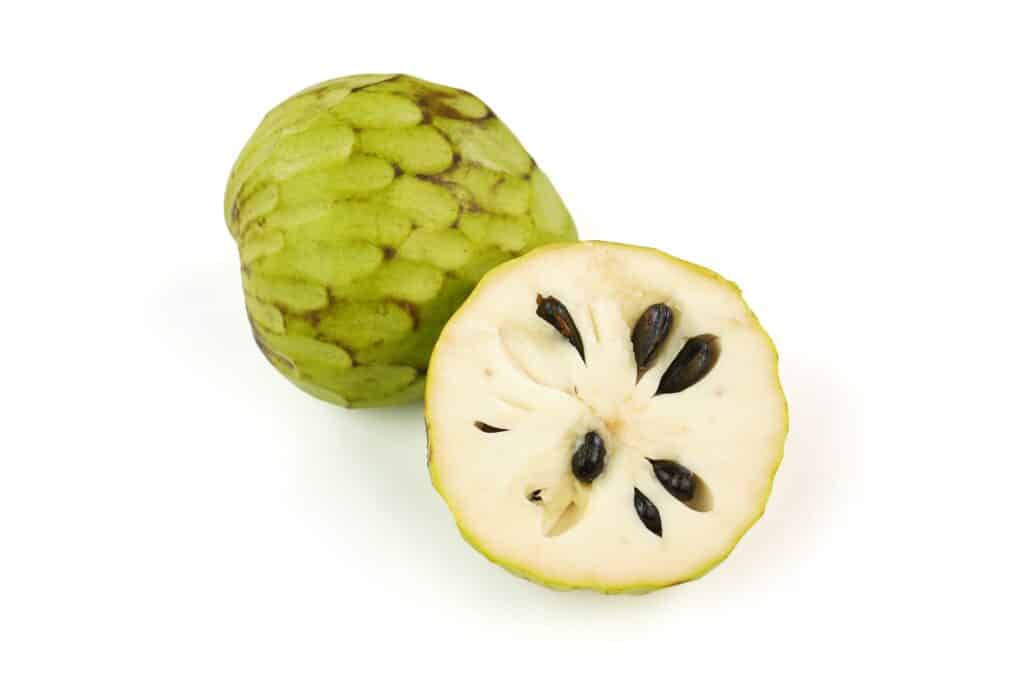
Cherimoya fruit have a unique interior in addition to their exterior.
©iStock.com/hayatikayhan
5. Cripps Pink Apple
The Cripps Pink apple, known for its distinctive colors and sweet-tart flavor, is a popular variety cherished by apple enthusiasts. This variety is originally from Australia.
The Cripps Pink Apple’s appearance is marked by its vibrant hues. Its skin showcases a gradient of colors, ranging from a deep pinkish-red blush over a green-yellow base. This striking contrast between pink and green gives the apple a visually appealing and appetizing look.
The Cripps Pink apple offers a delightful balance between sweetness and tanginess. Its crisp texture makes each bite refreshing, while the flavor profile is known for its juicy sweetness, coupled with a slight tartness. This blend of taste sensations has contributed to its popularity among consumers.
The Cripps Pink apple is also a source of valuable nutrients. It’s got a ton of dietary fiber that can help with digestive health. It’s also a great source of vitamin C.
6. Pitaya
The pitaya fruit, more well-known as the dragon fruit, is one of the most colorful multi-colored fruit in the world. It is native to Central America and parts of Asia but is now grown in various tropical and subtropical regions around the world.
The pitaya fruit comes in a variety of colors, including pink, yellow, and white. The skin is covered in scales or spikes, which lend it a distinct and captivating look. The flesh inside is speckled with tiny black seeds and is known for its subtly sweet flavor, reminiscent of a melon-like taste with a hint of pear. The texture is both creamy and crunchy, offering a delightful contrast.
Apart from its appealing appearance and pleasing taste, the pitaya fruit boasts notable nutritional properties. It’s low in calories and rich in dietary fiber, promoting digestive health and helping to control appetite. Additionally, pitaya is an excellent source of vitamin C, contributing to a strong immune system and healthy skin.
The fruit also contains antioxidants, such as betacyanins, which are responsible for its vibrant colors and have been associated with various health benefits, including reducing oxidative stress and inflammation.
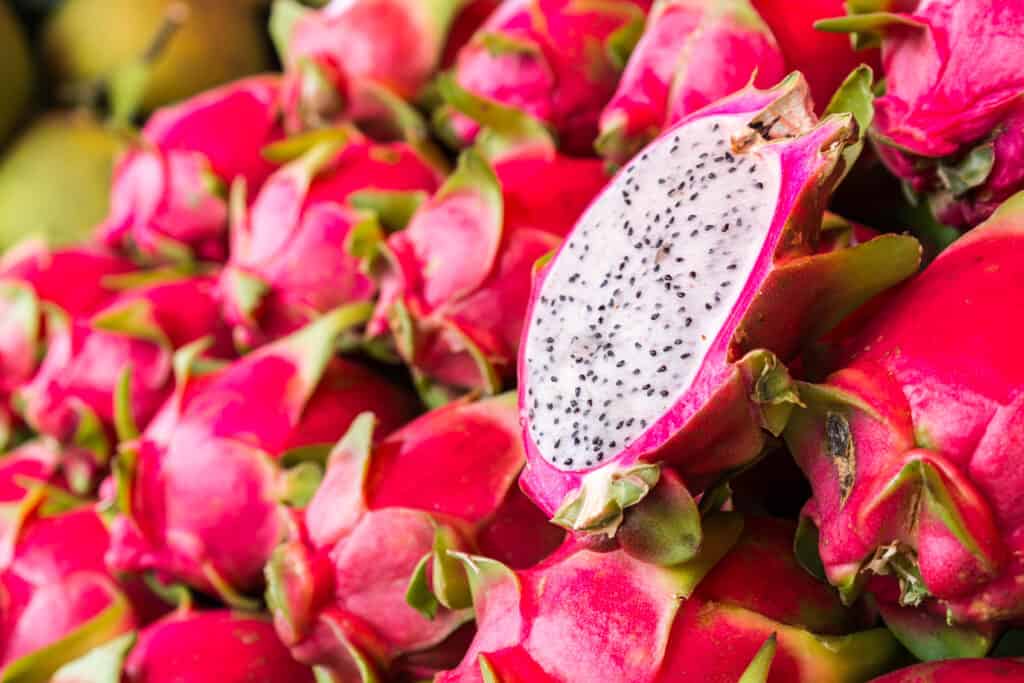
Pitaya fruits are grown from cacti.
©Pitchayarat Chootai/Shutterstock.com
7. Black Tomato
Since tomatoes are technically a fruit, we think they’re worthy of a spot on this list of multi-colored fruit! The black tomato, a unique and rare variety, stands out for its deep, dark colors that set it apart from traditional red tomatoes. Grown in various parts of the world, including Europe, Asia, and North America, the black tomato adds a touch of novelty to the culinary scene.
The color of black tomatoes ranges from a rich, dark purple to shades of deep burgundy and brown. These striking hues are due to high levels of anthocyanins, antioxidants that also contribute to their distinct flavor. While not truly black, the dark coloration gives the tomatoes a visually appealing and mysterious appearance.
Black tomatoes offer a balance of sweetness and acidity, often with a smoky undertone. The flavor is robust and earthy, making them a favorite among those seeking a unique and complex tomato experience. The texture can vary from tender to firm, depending on the specific variety.
Black tomatoes are surprisingly packed with nutritional benefits. They are a source of vitamins A and C, which are essential for maintaining healthy skin and supporting the immune system. Additionally, their high antioxidant content contributes to overall well-being by combating oxidative stress and inflammation.
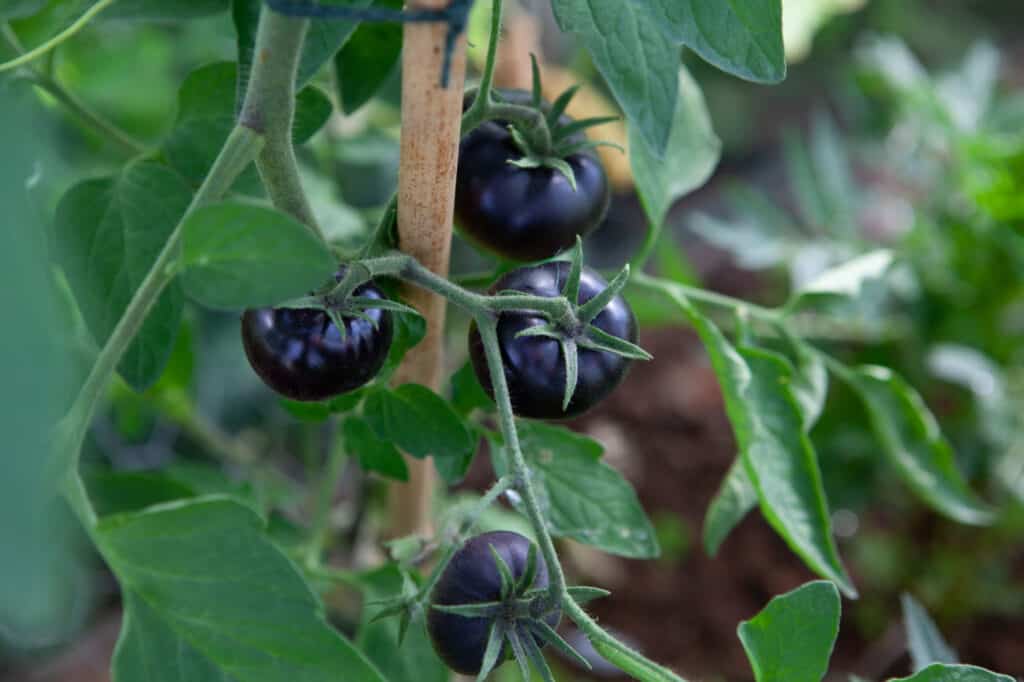
Black tomatoes can be entirely black in hue, but some varieties are deep purple, dark blue, and green.
©Jess Gregg/Shutterstock.com
8. Rainier Cherry
The Rainier cherry offers a delightful blend of colors that make it stand out in the cherry world. Primarily grown in the Pacific Northwest region of the United States, including Washington and Oregon, the Rainier cherry is celebrated for its unique qualities.
The colors of the Rainier cherry are a mesmerizing combination of golden yellow with blushes of bright red. This distinctive two-toned appearance is a result of careful crossbreeding. The cherries are delicate, with thin skin that showcases the exquisite color contrast. These hues not only make the Rainier cherry visually appealing but also an attractive addition to fruit displays and culinary creations.
The Rainier cherry boasts a sweetness that is unrivaled among cherry varieties. Its flavor is reminiscent of honey, with subtle undertones of vanilla. The texture is firm yet juicy, making each bite a burst of sweet and refreshing goodness.
These cherries are rich in antioxidants, including vitamins A and C, which play vital roles in promoting healthy skin, immune function, and overall well-being. They also contain dietary fiber, aiding in digestion and contributing to a feeling of fullness.

Rainier cherries are known for being sweeter than most cherry varieties in addition to their very pretty coloration.
©patjo/Shutterstock.com
9. Rambutan
The rambutan fruit originated in Southeast Asia. It’s a beautiful addition to the family of tropical fruits because of its unique coloring. It prefers warm, humid conditions and is hence widely cultivated in places like Indonesia, Thailand, Malaysia, and the Philippines.
The Malay word “rambutan” means “hairy” because of the rambutan’s distinctively hairy skin. The fruit’s colors, which begin as vivid green and deepen as the fruit ripens, include a wide spectrum of reds, yellows, and oranges. The hairy skin is elastic and easy to peel away, revealing the transparent, delicious meat of the fruit underneath.
The flavor of this fruit’s flesh is something like a cross between a grape and a lychee; it’s sweet and acidic. These fruits typically have one central seed and have a soft, juicy feel.
Vitamin C, which is abundant in rambutan, is beneficial to the immune system and the skin. Just as well, the antioxidants included in rambutan may help prevent cell damage caused by oxidative stress. The dietary fiber in rambutan contributes to healthy digestion and bowel function. Due to its high water content, this fruit is a great way to quench your thirst in warm weather.
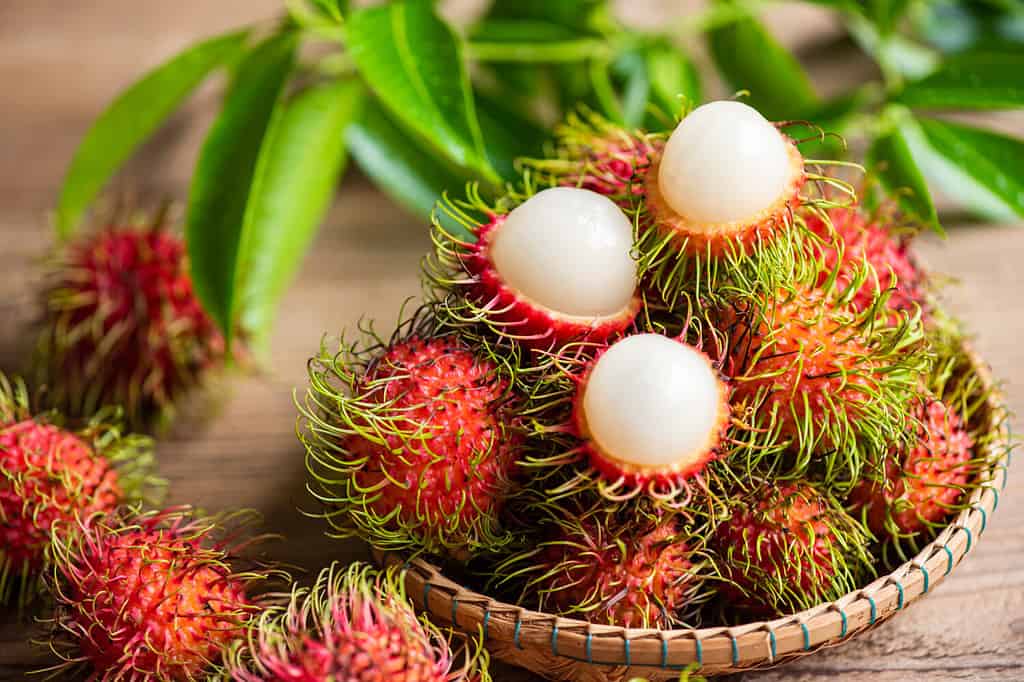
Rambutans have white, jelly-like interior fruits.
©Bigc Studio/Shutterstock.com
10. Golden Raspberries
The golden raspberry is a unique variant of the traditional red raspberry. It has a color palette that distinguishes it from the world of traditional berry colors. Widely cultivated in North America, Europe, and parts of Asia, the golden raspberry is cherished for its distinct qualities.
The colors of the golden raspberry range from pale yellow to a rich, golden hue. These warm tones set it apart from its red counterpart. The berries are delicate, with a velvety texture that adds to their visual appeal. The contrasting color and texture make the golden raspberry an eye-catching choice for both culinary uses and visual aesthetics.
The taste of a golden raspberry is a pleasant blend of sweetness and tartness. It has a flavor similar to that of a traditional red raspberry, but it’s softer and subtler. The berries are soft and luscious, so each mouthful is a rush of reviving flavor.
Golden raspberries, like red raspberries, are high in fiber and beneficial to digestive health and regular bowel movements. They have a lot of vitamin C, which helps the immune system and keeps the skin looking good, plus other vitamins and antioxidants.
Summary of Multi-Colored Fruits + More
| # | Fruit | Colors |
|---|---|---|
| 1 | Mango | Green, red, golden yellow |
| 2 | Starfruit | Yellow and green |
| 3 | Prickly Pear | Purple, yellow, green |
| 4 | Cherimoya | Light green and brown |
| 5 | Cripps Pink Apple | Blush and yellow |
| 6 | Pitaya | Green, yellow, magenta |
| 7 | Black Tomato | Red, deep dark green |
| 8 | Rainier Cherry | Red and light yellow |
| 9 | Rambutan | Yellow and intense red |
| 10 | Golden Raspberries | Golden yellow, cherry red |
| 11 | Watermelon | Light green, dark green |
| 12 | Pineapple Tomato | Golden yellow, orange |
| 13 | Ackee | Blush red, pale yellow |
| 14 | Kiwano | Red, orange, yellow |
| 15 | Blood Orange | Red, orange |
| 16 | Nectarine | Deep red, yellow |
| 17 | Atomic Grape Tomato | Deep blue, purple, green |
| 18 | Kiwi | Brown, green |
| 19 | Red Bananas | Maroon, pale yellow |
| 20 | Pineberry | White, red, green |
Thank you for reading! Have some feedback for us? Contact the AZ Animals editorial team.

